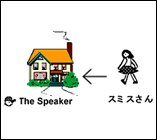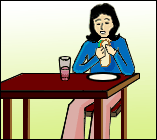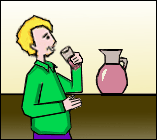|
Let's
check vocabulary.
| Food
and drink |
1. |
food |
たべもの |
9. |
raw
fish |
さしみ |
2. |
sushi |
すし |
10. |
meat/poultry |
にく |
3. |
vegetable |
やさい |
11. |
fish |
さかな |
4. |
Japanese
dish |
にほんりょうり |
12. |
Chinese
dish |
ちゅうかりょうり |
5. |
spaghetti |
スパゲッティ |
13. |
hamburger |
ハンバーガー |
6. |
pasta |
パスタ |
14. |
pizza |
ピザ |
7. |
chocolate |
チョコレート |
15. |
ice
cream |
アイスクリーム |
8. |
beer |
ビール |
16. |
water |
みず |
| Music |
1. |
jazz |
ジャズ |
4. |
rock |
ロック |
2. |
classical
music |
クラシック |
5. |
rap |
ラップ |
3. |
country
music |
カントリー |
6. |
pops |
ポップス |
| Sports |
1. |
baseball |
やきゅう |
4. |
swimming |
すいえい |
2. |
ski |
スキー |
5. |
soccer |
サッカー |
3. |
basketball |
バスケットボール |
6. |
golf |
ゴルフ |
| Movies |
1. |
comedy |
コメディー |
4. |
horror |
ホラー |
2. |
SF |
エスエフ |
5. |
love
story |
ラブストーリー |
3. |
drama |
ドラマ |
6. |
action |
アクション |
|
|
|
Someone |
は |
Noun |
が |
すき・
きらい |
です |
QM |
|
| Affirmative |
たなかさん |
は |
すし |
が |
すき |
です |
|
Tanaka-san likes sushi. |
| Question |
すし |
が |
すき |
です |
か |
Does Tanaka-san like sushi?
|
| Question word |
なに |
What does Tanaka-san like? |
| たなかさん |
は |
やさい |
は |
すき |
じゃありません |
Tanaka-san does not like vegetables. |
| たなかさん |
は |
やさい |
は |
きらい |
じゃありません |
Tanaka-san does not dislike vegetables. |
Topic |
は |
QW |
が |
|
|
|
|
| たべもの |
は |
なに |
が |
すき |
です |
か |
As for food, what do you like? |
| すし |
が |
すき |
です |
|
As for food, I like sushi. |
| |
どんな + Noun |
が |
|
|
|
|
| |
どんな たべもの |
が |
すき |
です |
か |
What kind of food do
you like? |
| とくに |
すし |
が |
すき |
です |
|
Especially, I like
sushi. |
| たなかさん |
は |
クラシック |
が |
すき |
です |
Tanaka-san likes classical (music). |
| たなかさん |
は |
ロック |
も |
すき |
です |
Tanaka-san likes rock too/also. |
| たなかさん |
は |
クラシック |
が |
すき |
です |
Tanaka-san likes classical. |
| スミスさん |
も |
クラシック |
が |
すき |
です |
Smith-san also likes classical. |
| |
は |
|
|
Connective
(but) |
|
は |
|
|
|
| クラシック |
は |
すき |
です |
けど、 |
ロック |
は |
あまり |
すき |
じゃありません |
| I like classical (music), but I do not like rock very much. |
|
|
Let's practice talking about one's preferences based
on the chart. Follow the example below.
| |
|
Items |
|
Degree
of preferences |
1. |
スミス |
バスケットボール |
 |
だいすき or いちばん すき |
2. |
きたむら |
エスエフ |
 |
すき |
3. |
山中 |
ビール |
 |
まあまあ すき |
4. |
すずき |
ちゅうかりょうり |
 |
あまり すきじゃありません |
5. |
リー |
ワイン |
 |
きらい or ぜんぜん すきじゃありません |
6. |
田中 |
ホラーえいが |
 |
だいきらい or いちばん きらい |
|
|
Let's practice talking about one's preferences based
on the chart. Provide your own answers to the following questions. Also, use とくに and なんでも in your answers.
Ex.
A: どんな おんがくが すきですか。(What kind of music...?)
B: クラシックが すきです。とくに、モーツァルト (Mozart) が すきです。
or なんでも すきです。
| |
Category |
Choices |
1. |
おんがく |
ジャズ、クラシック、ロック、ラップ |
2. |
たべもの |
にほんりょうり、ちゅうかりょうり、にく、やさい、ピザ、ハンバーガー |
3. |
のみもの |
コーヒー、こうちゃ、おちゃ、みず、ビール、ワイン |
4. |
スポーツ |
やきゅう、テニス、サッカー、スキー |
5. |
えいが |
コメディー、ラブストーリー、アクション、エスエフ、ホラー |
|
|
Let's
interview your classmates about their preferences by following
the model conversation below. After interviewing with each
other, come up with sentences which show similarities and
differences of each other's preferences.
A: [Name]さんは どんなおんがくが すきですか。
B: おんがくですか。 そうですね。わたしは、ジャズがすきです。
[Name]さんは?
A: わたしは、ロックが すきです。ジャズは あまり すきじゃありません。
or
A: わたしも、ジャズがすきです。
Ex.
Contrast: Aさんは ロックが すきですけど、Bさんは ジャズが すきです。
Similarity: Aさんは ロックが すきです。Bさんも ロックが すきです。
| |
Category |
Choices |
1. |
おんがく |
ジャズ、クラシック、ロック、ラップ |
2. |
たべもの |
にほんりょうり、ちゅうかりょうり、にく、やさい、ピザ、ハンバーガー |
3. |
のみもの |
コーヒー、こうちゃ、おちゃ、みず、ビール、ワイン |
4. |
スポーツ |
やきゅう、テニス、サッカー、スキー |
5. |
えいが |
コメディー、ラブストーリー、アクション、エスエフ、ホラー |
|
|
A: さかなと ぎゅうにくと どちらが すきですか。
B: さかなも ぎゅうにくも すきです。
| Ex. |

さかな
|

ぎゅうにく |
すきです |
1. |
サッカー |
フットボール |
すきです |
2. |
バスケットボール |
フットボール |
よくみます |
3. |
クラシック |
ロック |
よくききます |
4. |
ビール |
ワイン |
すきです |
5. |
でんわ |
メール |
つかいます |
6. |
タクシー |
でんしゃ |
はやいです |
7. |

すずきさん |

ブラウンさん |
いそがしいです |
|
|
Fill in the blanks in the following conversation.
| |
|
|
Implication |
1. |
たなか |
どんなたべものがすきですか。 |
|
2. |
スミス |
ピザ__ハンバーガーが すきです。
|
(Among other things I like...) |
3. |
たなか |
いま、へやには だれが いますか。 |
|
4. |
スミス |
ブラウンさん__やまださんが います
。
|
(And that's it.) |
5. |
ウェイター |
おのみものは? |
|
6. |
たなか |
コーラ__コーヒーを おねがいします。 |
(That's all I want.) |
| 4. |
たなか |
にほんごのクラスは いつですか。 |
|
| スミス |
げつようび__すいようび__きんようびです。 |
(Only those 3 days.) |
| たなか |
そうですか。 |
|
| 5. |
たなか |
どんな スポーツを よくみますか。 |
|
| スミス |
フットボール__やきゅうを みます。 |
(and others, too) |
| 6. |
たなか |
ジャズ__クラシック__ロックのうちで
どれが いちばん すきですか。 |
(Choose within these things) |
| スミス |
ロックが いちばんすきです。 |
|
|
|
Create a conversation similar to the example below.
A: だれが すいえいが すきですか。
B: たなかさんと すずきさんと よしださんが (すいえいが) すきです。
or
A: だれが すいえいが すきじゃありませんか。
B: ブラウンさんと やまださんが (すいえいが) すきじゃありません。
|
|

たなか
|

すずき |

ブラウン |

やまだ |

よしだ |
Others |
| Ex. |
すいえい |
|
|
|
|
|
|
1. |
フットボール |
|

|
|
|
|
|
2. |
クラシック |
|
|
|
|
|
|
3. |
おすし |
|
|
|
|
|
|
4. |
ビール |
|
|
|
|
|
|
|
|
Create a conversation similar to the example below. Be careful. Not all sentence end with すきです.
A: さかなと ぎゅうにくと とりの なかで どれが いちばん すきですか。
B: そうですね。さかなが いちばん すきです。
or
A: しんぶんと テレビと インターネットの なかで どれを いちばん よく みますか。
B: そうですね。インターネットを いちばん よく みます。
| Ex. |

さかな
1
|

ぎゅうにく
3 |

とり
2 |
すきです |
1. |
すいえい
2 |
テニス
1 |
ゴルフ
3 |
すきです |
2. |
フットボール
1 |
サッカー
2 |
やきゅう
3 |
よく みます |
3. |
クラシック
3 |
ジャズ
1 |
ロック
2 |
よく ききます |
4. |
ビール
2 |
ワイン
3 |
ウィスキー
1 |
すきです |
5. |
でんわ
2 |
メール
1 |
ファックス
3 |
よく つかいます |
6. |
タクシー
1 |
でんしゃ
2 |
バス
3 |
はやいです |
7. |

けんちゃん
|

すずきさん |

ブラウンさん |
ひまです |
|
|
|
|
The following shows what each person likes to do or does not like to do. State their likes (or dislikes) in Japanese by using the plain form of each verb.
e.g., たなかさんは くるまで いく の は すきですが、 でんしゃで いく の は すきじゃありません。
| |
Example |
1 |
2 |
3 |
4 |
| |

たなか |

すずき |

ブラウン |

よしだ |

やまだ |
|
くるまで
いきます |
おんがくを
ききます |
うちで
たべます |
おふろに
はいります |
ともだちと
のみます |
|
でんしゃで
いきます |
うたを
うたいます |
レストランで
たべます
|
シャワーを
あびます |
ひとりで (by oneself)
のみます |
|
|
Create a conversation like the one below.
A: たなかさんは なにを するのが すきですか。
B: (たなかさんは)すいえいを するのも フットボールを みるのも すきです。
|
|
Example |
1 |
2 |
3 |
4 |
|
|

たなか
|

すずき |

ブラウン |

やまだ |

よしだ |
| すいえい |
します |
|
|
|
|
|
| フットボール |
みます |
|

|
|
|
|
| クラシック |
ききます |
|
|
|
|
|
| おすし |
たべます |
|
|
|
|
|
| ビール |
のみます |
|
|
|
|
|
|
|
「~より ~のほうが」 is the structure that refers to the two sides that are compared.
- Xより means "than X."
- Yのほう is the side one likes more.
- Xより Yのほうが means "than X, ... Y".
- Note that the question word is どちら(のほう)
Based
on the following chart, let's carry out conversations about
one's preferences.
A: さしみと すしと どちら(のほう)が すきですか。(Between X and Y, which one do you like more?)
B: さしみより すし(のほう)が すきです。(I like sushi more than sashimi.)
| |
 |
 |
| Ex. |
さしみ |
すし |
| 1. |
ワイン |
ビール |
| 2. |
ジャズ |
ポップス |
| 3. |
テニス |
スキー |
|
|
The comparison can be about anything besides one's preference. It can be "Which one do you V more often ---A or B?" Note that the particle may change from が to others like を, に, etc. depending on how the sentence ends. Also, an additonal adjective like よく (often) may be used.
A: すしと さしみと どちら(のほう)を よく食べますか。
B:
わたしは、すしより さしみ(のほう)を よく食べます。
| |
less |
more |
|
| Ex. |
すし |
さしみ |
eat |
1. |
ビール |
ワイン |
drink |
2. |
ポップス |
ジャズ |
listen |
3. |
メール |
でんわ |
use |
4. |
としょかん |
りょう |
do homework |
5. |
がくせいかいかん |
ジュニアズ |
go (to eat lunch) |
|
|
Fill
in the blanks with appropriate particles (が, は, を, も,
と). Write an "X" if no particle is necessary.
| 1. |
A: どんな( )スポーツ( )すきですか。 |
| B: スポーツ( )ですか。やきゅう( )サッカー( )すきです。(I like baseball
and soccer.) |
| 2. |
A: たべものは なに( )いちばん すきですか。 |
| B: にく( )すきです。 |
| A: さかな( )どうですか。(How about
fish?) |
| B: さかな( )すきです。(I like fish also.) |
| A: わたし( )さかな( )すきですよ。(I also like fish.) |
| 3. |
A: えいがは なに( )よく みますか。 |
| B: ラブコメディー( )よく みますが、アクション( )あまり みません。 |
| 4. |
A: ピザ( )すきですか。 |
| B: いいえ、ピザ( )きらいです。 |
| A: スパゲッティー( )? |
| B: それ( )きらいです。(I dislike that also.) |
|
|
On T-Square's Voice Board (one of the Wimba links), record your part of the conversation (Part B) based on what you hear (Part A). Before going to the Voice Board, you can listen to Part A below. Type what you hear (Part A) and prepare your lines (Part B) accordingly below and practice your lines (Part B). When ready, go to T-Square and record your answers (Part B only). The same conversation is on T-Square's Voice Board.
|
今時月火水木金土曜半分週毎年間何 (16) |
You
will be asked to read and write the following kanji.
| |
Reading |
|
Writing |
1. |
大学一年生 |
1. |
げつようび |
2. |
今日 |
2. |
きょう |
3. |
毎日 |
3. |
きんようび |
4. |
土曜日 |
4. |
くじ |
5. |
水曜日 |
5. |
まいしゅう |
6. |
日曜日の一時半 |
6. |
なんねんせい? |
7. |
今、何分ですか。 |
7. |
もくようび |
Read the following conversation and answer the questions below.
キム: 山田さんは大学何年生ですか。
山田: 四年生です。
キム: そうですか。毎日クラスがありますか。
山田: いいえ、火曜日と木曜日の九時半から日本ごのクラスがあります。
そのクラスは九十分です。月水金にはクラスはありません。 |
- 山田さんは何曜日にクラスにいきますか。
- そのクラスは何時にはじまりますか。
- 何時におわりますか。
|
|



















